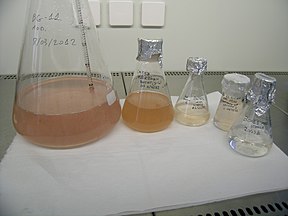| Planktothrix | |
|---|---|

| |
| Planktothrix rubescens | |
| Scientific classification | |
| Domain: | Bacteria |
| Phylum: | Cyanobacteria |
| Class: | Cyanophyceae |
| Order: | Oscillatoriales |
| Family: | Microcoleaceae |
| Genus: | Planktothrix Anagnostidis & Komárek, 1988 |
Planktothrix is a diverse genus of filamentous cyanobacteria observed to amass in algal blooms in water ecosystems across the globe. Like all Oscillatoriales, Planktothrix species have no heterocysts and no akinetes. Planktothrix are unique because they have trichomes and contain gas vacuoles unlike typical planktonic organisms.[1] Previously, some species of the taxon were grouped within the genus Oscillatoria, but recent work has defined Planktothrix as its own genus.[2] A tremendous body of work on Planktothrix ecology and physiology has been done by Anthony E. Walsby, and the 55.6 kb microcystin synthetase gene which gives these organisms the ability to synthesize toxins has been sequenced.[3] P. agardhii is an example of a type species of the genus.[4] P. agardhii and P. rubescens are commonly observed in lakes of the Northern Hemisphere where they are known producers of potent hepatotoxins called microcystins.[5]


- ^ Komarek J (2003). "Planktic oscillatorialean cyanoprokaryotes (short review according to combined phenotype and molecular aspects)". Hydrobiologia. 502: 367–382. doi:10.1007/978-94-017-2666-5_30. ISBN 978-90-481-6433-2.
- ^ Suda S, Watanabe MM, Otsuka S, Mahakahant A, Yongmanitchai W, Nopartnaraporn N, Liu Y, Day JG (September 2002). "Taxonomic revision of water-bloom-forming species of oscillatorioid cyanobacteria". International Journal of Systematic and Evolutionary Microbiology. 52 (Pt 5): 1577–1595. doi:10.1099/00207713-52-5-1577. PMID 12361260.
- ^ Christiansen G, Fastner J, Erhard M, Börner T, Dittmann E (January 2003). "Microcystin biosynthesis in planktothrix: genes, evolution, and manipulation". Journal of Bacteriology. 185 (2): 564–72. doi:10.1128/jb.185.2.564-572.2003. PMC 145317. PMID 12511503.
- ^ Komárek J, Komárková J (2004). "Taxonomic review of the cyanoprokaryotic genera Planktothrix and Planktothricoides" (PDF). Czech Phycology. 4: 1–8.
- ^ Sivonen K, Jones G (1999). "Cyanobacterial toxins". In Chorus I, Bertram J (eds.). Toxic cyanobacteria in water: a guide to public health significance, monitoring and management (PDF). London: E&FN Spon. pp. 41–111.